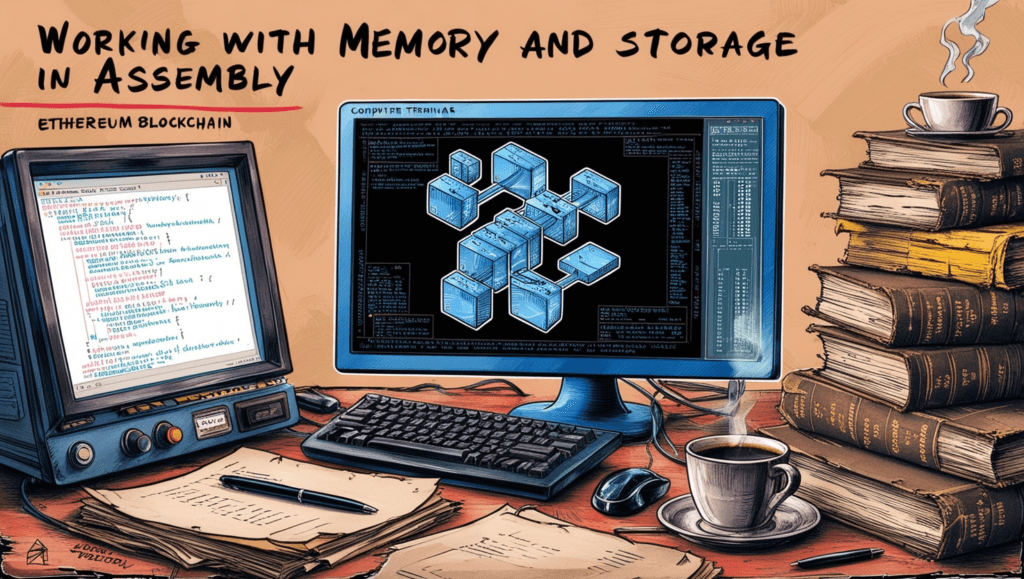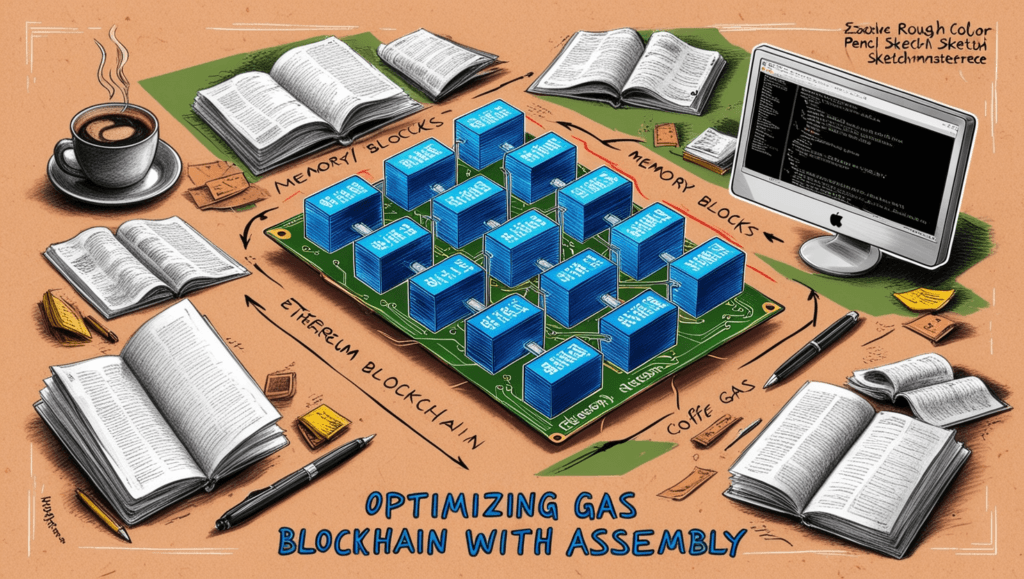Solidity Tutorial Chapter 18: Working with Assembly in Solidity– In Solidity, we’re often working within high-level constructs that make coding for Ethereum smart contracts approachable and reliable. But for developers who want to squeeze out every bit of efficiency or customize behavior in unique ways, Solidity Assembly is the powerhouse that lies beneath, ready to be used. While it’s not something every developer dives into, understanding how Assembly works in Solidity can give you an edge when you need precision, control, and cost-effectiveness.
In this chapter, we’ll break down what Assembly is in the context of Solidity, when to use it, and provide some practical examples to help you feel comfortable working with low-level code. If you’re new to Assembly, don’t worry—this guide will take you through it in a friendly, straightforward way.
Table of Contents
What is Assembly in Solidity?

Assembly, in the simplest terms, is a way to interact with the Ethereum Virtual Machine (EVM) at a low level. Unlike the Solidity language itself, which abstracts a lot of complex operations into easy-to-read functions, Assembly lets you write instructions closer to the “machine level.” This means you can be more explicit in your commands, directly manipulating memory and storage with increased control.
When we refer to Assembly in Solidity, we’re actually talking about something called “Yul,” a language developed by Ethereum that acts as the default inline assembly language for Solidity. Yul helps bridge high-level Solidity code with low-level EVM bytecode, making it easier to implement Assembly within Solidity functions.
Why Use Assembly in Solidity?
Using Assembly has its pros and cons. Here’s why you might consider using it:
- Gas Efficiency: Assembly allows you to optimize gas costs by removing unnecessary Solidity-level operations. In other words, you get a way to reduce costs by getting rid of overhead.
- Low-Level Control: Sometimes, you need to access specific EVM instructions or memory locations. Assembly provides access to the raw EVM opcodes, giving you the flexibility to create specialized solutions.
- Advanced Functionality: There are certain tasks that require lower-level interactions that Solidity doesn’t natively support. Assembly lets you accomplish these tasks in a way that otherwise wouldn’t be possible.
However, it’s worth noting that Assembly code can be less readable and harder to debug, which is why it’s usually recommended for seasoned developers who are familiar with EVM’s workings.
Getting Started with Assembly Syntax in Solidity
To incorporate Assembly in Solidity, you use the assembly block. This block allows you to define and write Assembly code within Solidity functions. Here’s a simple example:
pragma solidity ^0.8.0;
contract AssemblyExample {
function add(uint256 a, uint256 b) public pure returns (uint256 result) {
assembly {
result := add(a, b)
}
}
}In the example above, we use an assembly block to add two numbers. Notice the := operator, which is unique to Yul and is used to assign values within an assembly block.
Working with Memory and Storage in Assembly

One of the advantages of using Assembly is having direct control over memory and storage. Solidity normally manages these automatically, but Assembly lets you access specific memory slots, enabling fine-grained control.
In Solidity, memory is a temporary storage space used during the execution of a contract’s functions. Storage, on the other hand, is persistent and retains data between function calls.
Here’s an example of how to manipulate memory directly in Assembly:
pragma solidity ^0.8.0;
contract MemoryExample {
function storeInMemory(uint256 data) public pure returns (uint256) {
assembly {
let memLocation := mload(0x40)
mstore(memLocation, data)
return(memLocation, 32)
}
}
}In this code:
mload(0x40)loads the free memory pointer, a specific address in memory.mstorestores the data at the specified memory location.returnprovides the stored data back to the calling function.
With these instructions, you’re directly interacting with the contract’s memory, making the code leaner and potentially more efficient.
Practical Example: Optimizing Gas with Assembly

Gas optimization is one of the most popular uses of Assembly. Let’s look at an example where we perform a multiplication operation. In Solidity, you’d usually just use the * operator. But using Assembly can sometimes shave off a few gas units.
Here’s a basic example:
pragma solidity ^0.8.0;
contract GasOptimizationExample {
function multiply(uint256 a, uint256 b) public pure returns (uint256 result) {
assembly {
result := mul(a, b)
}
}
}This code doesn’t look much different, but because Assembly skips some of the overhead that Solidity introduces, you might save on gas costs. While the difference may be small for this function, in more complex operations, the savings can add up significantly.
Using Assembly for More Complex Calculations
Another great application of Assembly is in handling calculations that might be gas-intensive in Solidity. For example, finding the exponent of a number. Solidity lacks a built-in exponentiation function for uint256, so we can create one in Assembly:
pragma solidity ^0.8.0;
contract Exponentiation {
function power(uint256 base, uint256 exponent) public pure returns (uint256 result) {
assembly {
result := exp(base, exponent)
}
}
}The exp instruction is a low-level EVM operation that calculates exponents, which isn’t available directly in Solidity. Assembly lets us take advantage of these low-level opcodes to perform specialized calculations.
Handling Conditionals in Assembly

Assembly also allows for conditional logic, although it can appear quite different from what you might be used to in regular Solidity syntax. Here’s how a conditional statement might look:
pragma solidity ^0.8.0;
contract ConditionalExample {
function isEven(uint256 number) public pure returns (bool) {
bool result;
assembly {
switch mod(number, 2)
case 0 {
result := 1
}
default {
result := 0
}
}
return result;
}
}In this code:
mod(number, 2)checks ifnumberis even or odd.switchacts like anif-elsestatement, where we define cases based on conditions.
Tips and Caution When Using Assembly in Solidity
Using Assembly provides more control and efficiency but should be done carefully. Here are some tips:
- Test Rigorously: Assembly code can be hard to debug and maintain, so always test thoroughly.
- Use for Optimizations Only When Necessary: Most of the time, Solidity is efficient enough without Assembly. Use Assembly sparingly, and only when you know it will significantly improve performance.
- Keep It Readable: Comment Assembly code extensively, as it may be confusing for other developers (or even yourself) later on.
Conclusion
Assembly in Solidity might feel daunting at first, but with practice, it becomes an invaluable tool. By understanding how to work directly with EVM opcodes and memory, you can unlock new levels of optimization and control in your smart contracts. Whether it’s reducing gas costs, managing memory directly, or performing low-level calculations, Assembly offers a path to a deeper mastery of Solidity.
Using this guide, you’ll not only understand how to work with Assembly in Solidity but also appreciate its benefits and potential pitfalls. Keep experimenting with Assembly to find the perfect balance between high-level Solidity and low-level EVM control.


